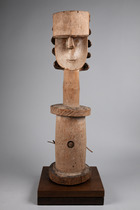Rare bust-shaped half figure · Gabon, Mbete (Ambete) · ID: 3050315
Woerner, Michael, Würzburg, Germany / Bangkok, Thailand
Description
wood, white and black pigment, base
The function of these bust-shaped half-figures is still unclear today. They are usually associated with the cult of relics. Reliquaries are widespread throughout western Equatorial Africa, from southern Cameroon to Gabon and the Congo (Brazzaville). These are containers in which the bones of revered ancestors and other important objects were kept and which were protected and guarded by separately crafted and inserted figures.
The Ambete created anthropomorphic figures that held relics in a cavity inside them and thus became relic figures themselves (cf. LaGamma, 2007, p. 273, fig. 92).
In addition, they produced these bust-shaped half-figures, which can be moulded with arms or without. They too can be equipped with openings for the insertion of relics, such as a figure from the Metropolitan Museum New York (AHDRC 0125291), which has a recess in the back. Or a figure from the Musée de l’ Afrique et de l’ Océanie, Paris, where the head can be removed from the vascular body like a lid (cf. (Meyer, 1991, p. 136, ill. 129).
In this half figure, a head with a striking hairstyle and a long neck sits on a cylindrical body. A formally very similar figure, ex Baron Eduard von der Heydt (1882-1964), is in the holdings of the Rietberg Museum Zurich (inventory no. RAf 811) (AHDRC 0044740). Neither object has any openings, as does another sculpture of this type (cf. AHDRC 0044714).
It is conceivable that they were attached to a corresponding container as part of a relic ensemble, comparable to the famous guardian figures of the Kota and Fang.
A completely different approach is offered by J.- C. Andrault, who collected a comparable object on site in the Okondja region in 1960/61 (AHDRC 0044718). He suggested that these bust-like half-figures might have been used in the performance of circumcision ceremonies.
Comparing literature
LaGamma, Alisa (ed.), Eternal Ancestors, New York 2007, p. 273, ill. 92 Meyer, Laure, Schwarzafrika, Paris 1991, p. 136, ill. 129 Ghent, Gregory, Emblems of passage, San Francisco 2002, p. 120 f.




